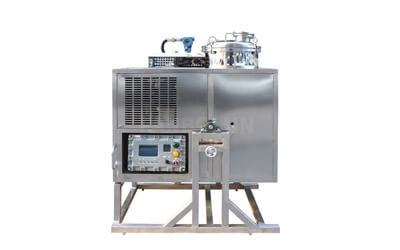Struggling with high solvent costs in your cannabis extraction? Concerned about environmental impact and operational inefficiencies? We understand these challenges.
Optimizing solvent recovery can significantly boost your profits by drastically cutting solvent expenses, minimizing waste, improving product purity, and ensuring regulatory compliance. It's a smart investment for sustainable growth in the competitive cannabis market.

As a manufacturer with over 16 years of experience in laboratory and production equipment, especially extraction and recovery systems, I've seen firsthand how crucial efficient solvent management is. Many businesses in the cannabis sector are discovering that the path to higher returns isn't just about yield, but also about smart resource management. Let me share some insights on how you can achieve this and why it's becoming essential, not just optional.
Why is Solvent Recovery a Game-Changer in Cannabis Extraction?
Are solvent expenses eating into your cannabis profits? Worried about the environmental footprint of your extraction process? This common issue needs a real solution.
Solvent recovery is a game-changer because it slashes operational costs by recycling expensive solvents, promotes environmental sustainability by reducing hazardous waste, enhances workplace safety, and can even improve the final purity of your cannabis extracts.
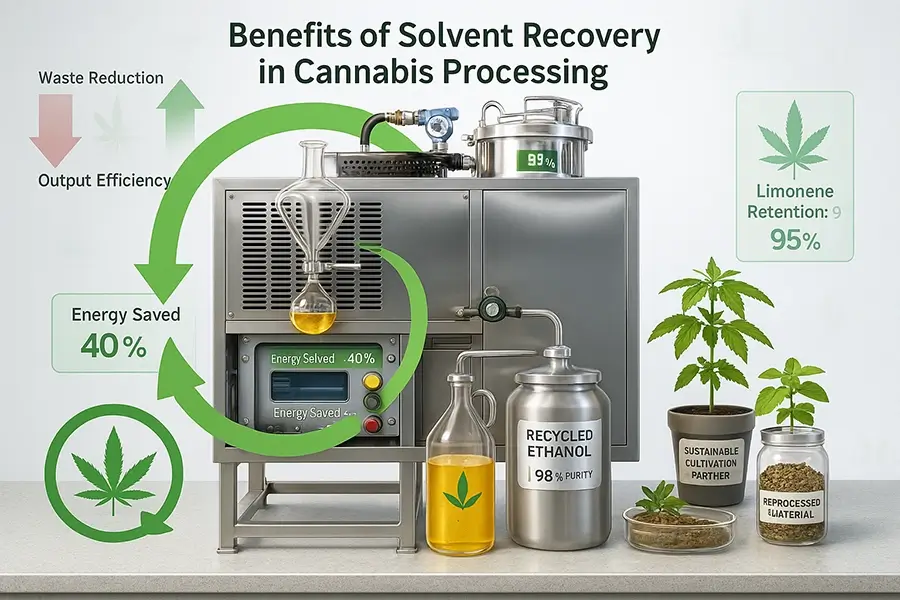
When we talk about solvent recovery, we're looking at a multifaceted solution that addresses several pain points in cannabis extraction. It's not just about saving money; it's about building a more resilient and responsible business. I've worked with numerous clients who initially focused only on the extraction process itself, only to realize later that their solvent consumption was a huge unchecked expense and a significant operational bottleneck.
The Economic Edge: Slashing Solvent Costs
The most immediate impact of implementing a solvent recovery system is the drastic reduction in solvent purchasing costs. Solvents like food-grade ethanol can be expensive, especially when used in large quantities for commercial-scale extraction. A good recovery system can recycle 90-98% of your solvent. Imagine reducing your monthly solvent bill by that much! For example, if you use 500 liters of ethanol a week, and your solvent costs $5 per liter, recovering 95% means saving over $2,300 weekly. This saving goes directly to your bottom line. I remember a client who was initially hesitant due to the upfront investment. After just three months of using our solvent recovery unit, their solvent purchase orders had dropped by over 90%, and they were projecting a full ROI within eight months.
Eco-Friendly Operations: Meeting Sustainability Goals
The cannabis industry is increasingly under scrutiny for its environmental impact. Disposing of large volumes of solvent, especially those containing residual cannabinoids or other plant matter, can be an environmental hazard and costly. Effective solvent recovery significantly reduces the volume of hazardous waste, helping your business meet sustainability goals and comply with environmental regulations. Reducing volatile organic compound (VOC) emissions is another critical benefit, improving air quality around your facility and contributing to a greener brand image, which consumers increasingly value.
Safety First: Minimizing Hazards
Many solvents used in cannabis extraction are flammable and can be hazardous if not handled properly. Reducing the amount of solvent stored on-site and minimizing handling through closed-loop recovery systems significantly enhances workplace safety. This reduces the risk of spills, fires, and operator exposure to potentially harmful fumes. Our systems, for instance, are designed with safety features like over-pressure protection and are built to meet stringent standards (like CE certification, with options for explosion-proof configurations), giving you peace of mind.
Purity and Quality: Enhancing Your Extracts
Efficient solvent recovery can also contribute to a higher quality end product. By effectively removing the solvent from the extract, you can ensure lower residual solvent levels in your final oils and concentrates. This is crucial for meeting regulatory limits and for producing a cleaner, purer product that is more appealing to discerning consumers. Consistent solvent quality, achieved through proper recovery and re-purification, also leads to more consistent extraction results.
What Key Factors Should You Consider When Choosing a Solvent Recovery Machine?
Overwhelmed by the options for solvent recovery systems? Unsure which features truly matter for your cannabis extraction facility? Choosing correctly is key to maximizing your return.
Key factors include the machine's recovery rate, processing capacity matched to your scale, compatibility with your solvents (e.g., ethanol, hydrocarbons), safety certifications (like CE, explosion-proof ratings), ease of operation and maintenance, and reliable after-sales support.
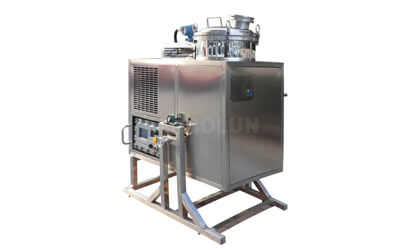
Solvent Recycling Equipment (90L)
Model: T-90EX
Feed capacity(L): 90
Power(kW): 5
Recovery(%): 95
View More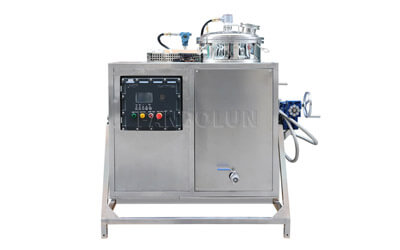
Solvent Recycler Machine (125L)
Model: T-125EX
Feed capacity(L): 125
Power(kW): 6
Recovery(%): 95
View More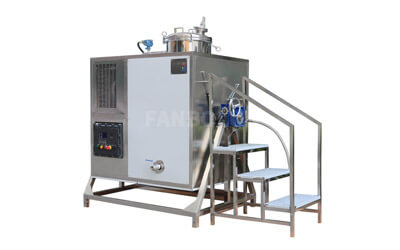
Solvent Recycling Machine (250L)
Model: T-250EX
Feed capacity(L): 250
Power(kW): 16
Recovery(%): 95
View More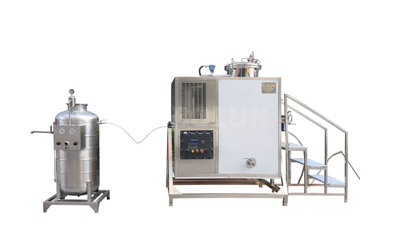
Solvent Recycling System (600L)
Model: T-600EX
Feed capacity(L): 600
Power(kW): 32
Recovery(%): 95
View More
Selecting the right solvent recovery machine is a critical decision. It’s not just about buying a piece of equipment; it's about integrating a vital component into your production line. As someone who has been involved in the design and export of these machines for over 16 years, I can tell you that a little homework upfront can save a lot of headaches later. We always encourage our clients to look beyond the price tag and consider the long-term value and operational fit.
Decoding Recovery Rates and Capacity
A high recovery rate (ideally 95% or more for many common solvents) is paramount for maximizing cost savings. However, this rate must be achievable consistently under your specific operating conditions. Capacity is equally important. Your machine should be able to process the volume of solvent you use within your operational timeframe. Undersizing will create bottlenecks, while oversizing can lead to unnecessary capital expenditure and potentially inefficient operation if run below its optimal capacity. We always discuss daily processing needs with clients to recommend the appropriately sized unit.
Solvent Compatibility: Not a One-Size-Fits-All
Different solvents (ethanol, butane, propane, hexane, etc.) have different physical and chemical properties. The materials of construction (like stainless steel grade, gasket materials such as PTFE) and the operating parameters (temperature, vacuum levels) of the recovery system must be compatible with the specific solvent(s) you use. For example, hydrocarbon recovery often requires systems designed for higher pressures and stricter explosion-proof standards compared to ethanol recovery. We ensure our equipment is built with the right materials for the intended application.
Safety is Non-Negotiable: Certifications and Features
Given the flammable nature of many extraction solvents, safety is the utmost priority. Look for machines with recognized certifications like CE (for European markets) or UL/CSA (for North America), and appropriate explosion-proof ratings (e.g., ATEX, Class I Division 1) if required for your facility and solvent type. Essential safety features include over-temperature and over-pressure protection, emergency stop buttons, and robust construction. Our commitment to quality, backed by ISO9001 certification, means we prioritize these safety aspects in our designs.
Ease of Use, Automation, and Maintenance
A system that is difficult to operate or clean will reduce your overall efficiency. Look for user-friendly interfaces, clear operating procedures, and ease of maintenance. Automation can range from semi-automatic to fully automatic cycles, reducing labor costs and minimizing the chance of human error. We design our equipment with the operator in mind, and many of our engineers are fluent in English, which helps in providing clear operational support.
The Importance of After-Sales Support
What happens if something goes wrong, or if you need help optimizing performance? Reliable after-sales support is crucial. This includes availability of spare parts, technical assistance, and warranty coverage. We were the first manufacturer in China in our field to establish a 24/7 after-sales support team, because we understand that downtime is costly. A one-year warranty and lifetime cost-price service are part of our commitment.
| Feature | Importance for Cannabis Extraction | What We Focus On |
|---|---|---|
| High Recovery Rate | Maximizes ROI, reduces solvent waste, lowers operating costs. | Systems designed for up to 98% recovery for many common solvents. |
| Appropriate Capacity | Matches your production scale, avoids bottlenecks or inefficiencies. | Range of sizes, custom solutions available. |
| Safety Features & Certs | Essential for flammable solvents, operator safety, regulatory compliance. | CE certification standard, explosion-proof options, ISO9001 quality. |
| Material Quality | Ensures durability, prevents contamination of solvent and extract. | High-grade stainless steel, PTFE seals, quality components. |
| Ease of Operation | Reduces training time, minimizes errors, improves efficiency. | User-friendly controls, options for automation. |
| After-Sales Support | Minimizes downtime, ensures longevity of equipment, provides peace of mind. | 24/7 global hotline, 1-year warranty, lifetime cost-price service. |
How Can Efficient Solvent Recovery Directly Impact Your Bottom Line?
Wondering if investing in solvent recovery is truly worth it? Skeptical about the direct financial benefits for your cannabis business? Let's clarify with facts.
Efficient solvent recovery directly boosts your bottom line by massively reducing expenditure on new solvents, lowering hazardous waste disposal costs, increasing production uptime through continuous solvent availability, and improving overall operational efficiency, leading to a faster return on investment.
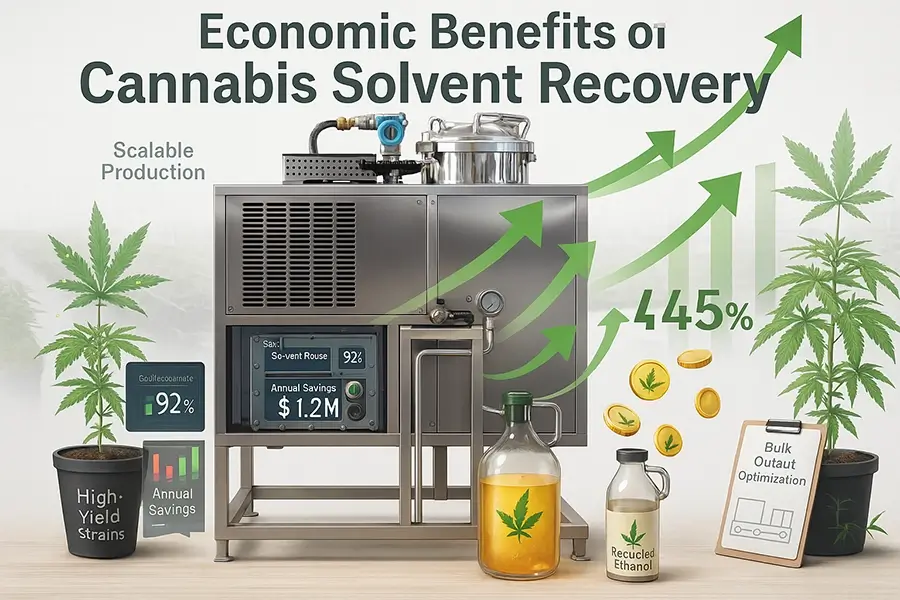
The financial argument for solvent recovery in cannabis extraction is compelling. It’s not just an operational improvement; it’s a strategic financial decision. Over my years in this industry, I've consistently seen that businesses implementing effective solvent recovery gain a significant competitive advantage. Let's break down how these savings accumulate and contribute to your profitability.
Direct Savings: The Obvious Win
This is the most straightforward benefit. If you use 1000 liters of ethanol per month at a cost of $5 per liter, that’s a $5,000 monthly expense. A solvent recovery unit that recycles 95% of this ethanol saves you $4,750 every month on solvent purchases alone. Annually, this amounts to $57,000. This direct reduction in operational expenditure (OPEX) is often the primary driver for investment, and rightly so. The less solvent you buy, the more profit stays in your business.
Indirect Savings: The Hidden Bonuses
Beyond direct solvent purchase savings, there are other significant cost reductions. Consider hazardous waste disposal. Used solvents, especially those laden with plant matter or other residues, can be expensive to dispose of in compliance with environmental regulations. Recovering and reusing your solvent drastically reduces this waste stream and its associated costs. Furthermore, efficient modern recovery units can be designed for energy efficiency, potentially lowering your utility bills compared to older or less optimized systems. Reduced storage needs for fresh solvent can also free up valuable facility space.
Boosting Production Throughput and Consistency
Having a reliable, on-site source of clean solvent means you're not dependent on external suppliers and their delivery schedules. This can prevent costly production downtimes. Moreover, by reusing solvent of a consistent quality (after it’s been through the recovery system), you can achieve more predictable and consistent extraction results, leading to better quality control and product reliability. This operational smoothness indirectly contributes to profitability by ensuring steady output.
Calculating Your Return on Investment (ROI)
The ROI for a solvent recovery system can often be surprisingly quick. To calculate it, you'd consider the initial investment (machine cost, installation, training) against the ongoing savings (reduced solvent purchase, lower disposal fees, potentially lower labor if automated). I've worked with cannabis and hemp processors who've reported their solvent recovery unit paying for itself in as little as 6 to 18 months. For instance, a client processing hemp in Oregon told me their system, which cost around $40,000, paid for itself within 10 months purely from the savings on ethanol purchases and reduced waste hauling fees.
What Are the Steps to Effectively Integrate a Solvent Recovery System into Your Workflow?
Thinking about adding solvent recovery but unsure how to integrate it smoothly? Worried about disrupting your current cannabis extraction operations? Proper planning is crucial.
Effective integration involves assessing your current solvent usage and waste, selecting a system tailored to your needs, planning the installation carefully to minimize downtime, thoroughly training your operators, and establishing a routine maintenance schedule for optimal performance.
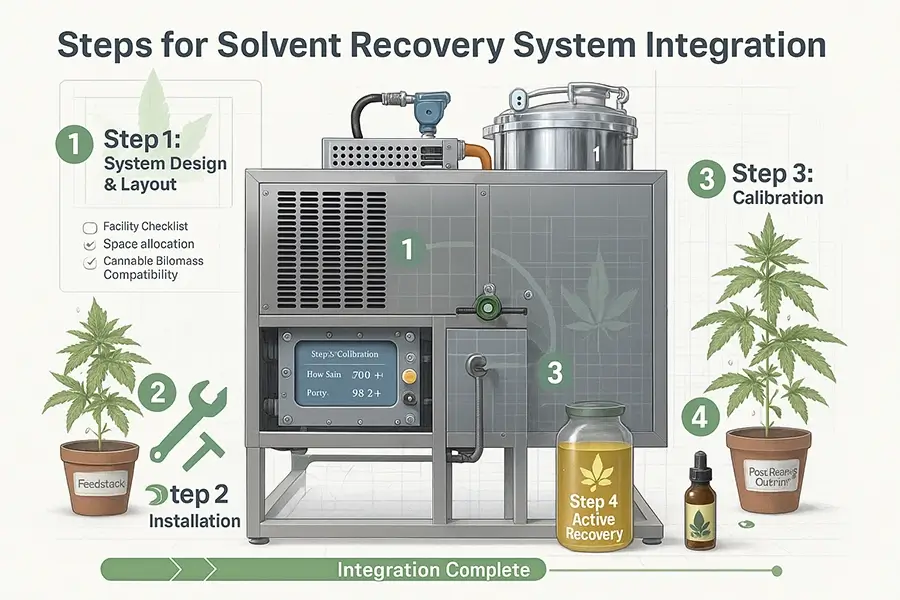
Integrating a new piece of major equipment like a solvent recovery system into an existing cannabis extraction workflow requires careful planning and execution. It's more than just plugging in a machine. My experience has shown that a phased approach works best to ensure a smooth transition and maximize the benefits from day one. We aim to be partners in this process, not just suppliers.
Phase 1: Assessment and Planning
Before you even look at specific machines, a thorough assessment of your current operations is vital. This includes: quantifying your solvent types and daily/weekly consumption, analyzing your current solvent waste volume and disposal methods/costs, evaluating available space and utility connections (power, cooling water, ventilation) for the new system, and understanding your future growth plans to ensure the system can scale if needed. We often guide clients through this needs-analysis phase.
Phase 2: System Selection and Customization
Once you have a clear picture of your needs, you can start selecting an appropriate system. This is where working closely with an experienced manufacturer like us, with over 16 years in the field, becomes invaluable. We can help you choose from standard models or discuss customizations to perfectly fit your solvent type, capacity requirements, safety standards, and automation level. We’ll consider factors like required recovery rates and desired purity of the recovered solvent.
Phase 3: Installation and Commissioning
Proper installation is key to safe and efficient operation. This phase should include site preparation, physical installation of the unit, connection to utilities, and thorough safety checks. Commissioning involves initial test runs, often with water or a small batch of solvent, to ensure everything is working as designed and to fine-tune operating parameters. Our engineering team, many of whom are fluent in English, can provide guidance or on-site support for this, ensuring a smooth start-up.
Phase 4: Operator Training
Your team needs to be comfortable and proficient in operating and maintaining the solvent recovery system. Comprehensive training should cover: standard operating procedures (SOPs), safety protocols, routine maintenance tasks (e.g., cleaning, checking seals, monitoring performance), and basic troubleshooting. We provide detailed manuals and can offer training sessions to ensure your staff is well-prepared.
Phase 5: Ongoing Maintenance and Optimization
A solvent recovery system, like any piece of machinery, requires regular maintenance to perform optimally and have a long service life. This includes scheduled checks, replacement of wear-and-tear parts (like gaskets), and periodic performance reviews. As you gain experience with the system, there might be opportunities to further optimize its performance or integrate it even more seamlessly with your evolving extraction processes. Our 24/7 after-sales support isn't just for breakdowns; it’s a resource for ongoing advice and optimization to ensure you get the most out of your investment.
Optimizing solvent recovery in cannabis extraction isn't just cost-saving; it's a strategic move for profitability, sustainability, and quality. We're here to help you achieve those high returns.

